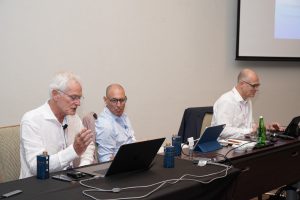
EuroSIVA in Abu Dhabi: A Successful First Step ✨
On 14 September 2025, EuroSIVA had the privilege of participating in the Abu Dhabi Annual Anesthesia Congress (ADAAC), organized in conjunction with the Euro-Abu Dhabi Intensive Care Congress. For the first time in the Middle East, we hosted a TIVA/TCI Workshop at the Conrad Abu Dhabi Etihad Towers. The program included lectures on pharmacokinetics, pharmacodynamics, EEG monitoring, and drug interactions, as well as sessions on PK/PD modeling, TCI in special populations (children, elderly, obese), and practical exercises with TCI pumps and the TIVATrainer software. In addition to the workshop, EuroSIVA also contributed to the main scientific program with a symposium that addressed key aspects of TIVA and TCI: Why and how to do TIVA with TCI – Dr. Francisco A. Lobo Drug interactions – Dr. Frank Engbers The Eleveld universal PK/PD model for propofol – Dr. Hugo Vereecke Participants from the region and beyond joined these sessions, engaging with an international panel of experts: Dr. Francisco A. Lobo (UAE) –
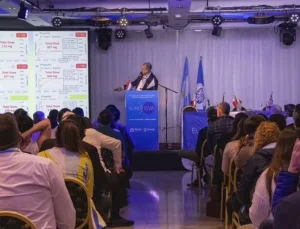
EUROSIVA 2025: A Historic Milestone in Buenos Aires
Following previous scientific events in Chile (2011 and 2019) and Colombia (2013), EUROSIVA once again crossed European borders — this time to Buenos Aires, which proved to be the ideal host. From May 15th to 17th, over 550 anesthesia professionals, including 70 colleagues from Latin America, gathered for a unique, immersive event centered on Total Intravenous Anesthesia (TIVA) and intraoperative monitoring. This remarkable edition of EUROSIVA was made possible through the invaluable collaboration with FAAAAR (Argentinian Federation of Anesthesia, Analgesia and Resuscitation Associations) and under the auspices of the World Federation of Societies of Anesthesiologists (WFSA). Together, we offered an outstanding scientific program addressing key topics such as pharmacokinetics and pharmacodynamics in TIVA, advances in target-controlled infusion (TCI), brain monitoring, the role of adjuvants, and novel agents like ciprofol. Special attention was also given to TIVA strategies in specific patient populations and the future of environmentally sustainable anesthesia. Throughout the three days, participants engaged in lectures, hands-on workshops, live demonstrations,

EUROSIVA Lisbon 2025: A Resounding Success in Advancing IV Anesthesia Education
On May 23–24, 2025, more than 100 anesthesiologists and critical care professionals from across Europe and beyond gathered in Lisbon, Portugal, for the EuroSIVA Lisbon 2025 Postgraduate Course on IV Anaesthetic Pharmacology and Perioperative Monitoring. Held at the Main Auditorium of the Edifício Egas Moniz, Faculdade de Medicina de Lisboa, this immersive two-day event offered high-level scientific discussions, practical insights, and collaborative exchange — all under the banner “Make TIVA Simple Again.” Accredited with 15 CME credits by the European Accreditation Council for Continuing Medical Education (EACCME®), the course provided participants with the opportunity to deepen their understanding of Total Intravenous Anesthesia, pharmacokinetics, pharmacodynamics, and multimodal perioperative monitoring. Scientific Highlights Day 1 – May 23 The course opened with foundations in TIVA, featuring insightful lectures by renowned speakers: Francisco Lobo explored the rationale for using TIVA, Johan Raeder covered pharmacokinetics, Frank Engbers delivered a memorable talk on pharmacodynamics titled “My Ke0 is better than yours”, Hernan Boveri explained allometric scaling in
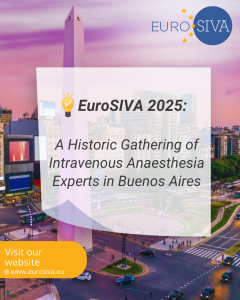
EuroSIVA 2025: A Historic Gathering of Intravenous Anaesthesia Experts in Buenos Aires
For the first time since its foundation in 1998, EuroSIVA – the European Society for Intravenous Anaesthesia – will host its full-format event outside Europe. From May 15 to 17, 2025, Buenos Aires will welcome leading anaesthesiologists, researchers, and clinicians from around the world for a three-day conference fully dedicated to Total Intravenous Anaesthesia (TIVA). A Milestone in Anaesthesia Education EuroSIVA has been a key player in education and research in intravenous anaesthesia pharmacology. This year’s event at Palais Rouge in Buenos Aires marks an exciting expansion of its global reach. The conference will include keynote lectures, interactive workshops, and live clinical case discussions, focusing on TIVA, Target-Controlled Infusion (TCI), and advanced perioperative monitoring. This event is part of EuroSIVA on Tour, a new initiative bringing intravenous anaesthesia education beyond Europe. Other activities include EuroSIVA’s participation in ADAAC 2025 – the leading anaesthesia educational event in the Gulf Region. Programme Highlights The agenda will cover a wide range of topics
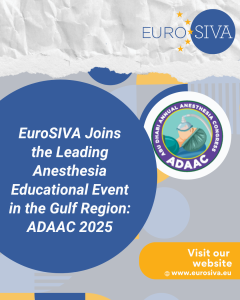
EuroSIVA Joins the Leading Anesthesia Educational Event in the Gulf Region: ADAAC 2025
EuroSIVA is proud to announce its participation in the Abu Dhabi Annual Anesthesia Congress (ADAAC), the premier educational event for anesthesiologists in the Gulf region, organized in conjunction with the Euro-Abu Dhabi Intensive Care Congress. For the first time in the Middle East, EuroSIVA will host an exclusive Total Intravenous Anesthesia (TIVA/TCI) Workshop on 14 September 2025 at Conrad Abu Dhabi Etihad Towers, UAE. The workshop agenda includes plenary lectures on pharmacokinetics, pharmacodynamics, EEG monitoring, and drug interactions, as well as focused sessions on PK/PD modeling, TCI in special populations (children, elderly, obese), and practical exercises with TCI pumps and TIVATrainer software. Participants will have the opportunity to learn from leading international experts in the field: Dr. Francisco A. Lobo (UAE) – EuroSIVA Chairman and Editor-in-Chief of Journal of Clinical Monitoring and Computing Dr. Siarhei Kastsiauchenka (UAE) – Anesthesiologist at Cleveland Clinic Abu Dhabi Dr. Frank Engbers (Netherlands) – EuroSIVA secretary and Developer of TIVATrainer and LabelSyringe Dr. Hugo Vereecke
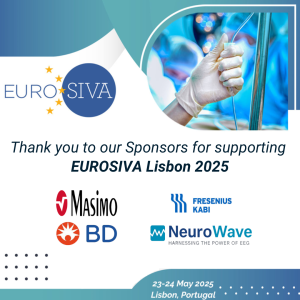
Thank you to our Sponsors for supporting EUROSIVA Lisbon 2025!
We are pleased to express our deepest gratitude to Fresenius, Masimo, Neurowaves, and BD for their generous support of Lisboa 2025 – Make TIVA Simple Again, our upcoming postgraduate course on IV Anesthetic Pharmacology and Perioperative Monitoring. The event will take place on May 23–24, 2025, at the Main Auditorium, Edifício Egas Moniz, Faculdade de Medicina de Lisboa. This high-level academic gathering has been awarded 15 CME credits by the European Accreditation Council for Continuing Medical Education (EACCME), underscoring the educational value and relevance of the program. Thanks to our sponsors, we are able to bring together leading experts in intravenous anesthesia and perioperative care to share cutting-edge insights, foster interactive learning, and contribute to the continuous professional development of anesthesiologists and critical care providers. 📝 Registration is now open: http://eurosiva.eu/registration We look forward to welcoming you in Lisbon for two days of stimulating lectures, practical knowledge, and collaborative exchange. Once again, thank you to Fresenius, Masimo, Neurowaves, and BD

Eurosiva 2025: Highlights from the Scientific Programme
Join us in Lisbon, Portugal, for the EUROSIVA 2025 Postgraduate Course on IV Anaesthetic Pharmacology and Perioperative Monitoring, awarded 15 CME credits by the EACCME®. 📅 Dates: 23–24 May 2025 📍 Venue: Main Auditorium, Edificio Egas Moniz, Faculdade de Medicina de Lisboa 🧠 Highlights from the Scientific Programme: 🎤 Day 1 – Friday, May 23 Session 1 – Basics in TIVA Why to use TIVA – Francisco Lobo Pharmacokinetics – Johan Raeder Pharmacodynamics: My KeO is better than yours – Frank Engbers Allometric scaling – Hernan Boveri TCI and drug interactions – Gavin Kenny Optimizing TCI in clinical practice – Nick Sutcliffe Session 2 – Updates on IV Anaesthetic Drugs Lidocaine, Ketamine, Remimazolam, Dexmedetomidine with Frank Engbers, Luc Barvais, Nick Sutcliffe and Francisco Lobo Session 3 – Monitoring and Multimodal Strategies Multimodal anesthesia and sedation – Francisco Lobo Multimodal monitoring – Luc Barvais TivatrainerX workshop – Frank Engbers 🎤 Day 2 – Saturday, May 24 New applications: Patient Maintained Sedation

Eurosiva Lisbon 2025 Awarded 15 CMEs by EACCME®
We are pleased to announce that the Eurosiva Lisbon 2025 postgraduate course on IV Anesthetic Pharmacology and Perioperative Monitoring has been awarded 15 CME credits by the European Accreditation Council for Continuing Medical Education (EACCME®). This accreditation underscores the course’s high educational value for anesthesiologists looking to enhance their knowledge and skills in Total Intravenous Anesthesia (TIVA). By attending, participants will not only gain cutting-edge insights into IV anesthetic pharmacology but also earn valuable CME credits to advance their professional development. 📅Event Details: Dates: May 23-24, 2025 Location: Lisbon, Portugal Registration: http://eurosiva.eu/registration Additionally, this year’s Eurosiva Lisbon course takes place immediately before the ESAIC Euroanaesthesia Congress, making it an excellent opportunity to combine both educational experiences in one trip. Participants can deepen their TIVA expertise at Eurosiva and then continue their learning journey at one of the largest anesthesia congresses in the world.Register now and take advantage of this unique opportunity to expand your expertise, connect with international experts, and
